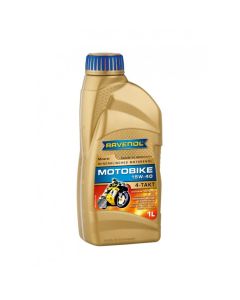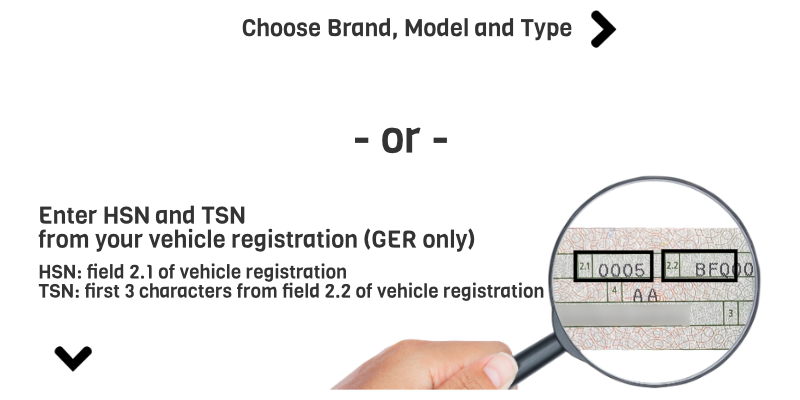15W-40 | Motorbike Engine Oil
-
 RAVENOL Motobike 4-T Mineral SAE 15W-40As low as €11.49
RAVENOL Motobike 4-T Mineral SAE 15W-40As low as €11.49- mineral engine oil with ester additives
- for wet and oil lubricated clutches
- 20W-40 oil with API SM specification
Buy the right motorcycle engine oil for your machine at low price!
When buying the right engine oil, it basically depends on the same criteria as in the car or in other motor vehicles:
The choice of the right oil is essential. But why is this so?
As in passenger cars, engines are being developed at a rapid pace due to the ever-increasing demand for new performance spheres coupled with requirements for vehicle emission values. The complexity of individual components is increasing and, as a consequence of the rising demands, the combustion engine is becoming more and more technical and precise.
In order to achieve performance and, more importantly, to provide sufficient protection under these conditions, the demands on the lubricants used are also increasing. As a result, motorcycle engine oils are also becoming increasingly differentiated. This is expressed in various specifications, manufacturer approvals and oil manufacturer recommendations.
Motorcycle engine oil - What are the differences?
Also with the motorcycle the question arises with the multiplicity at engine oils on the market and in on-line Shop of ATO24 justifiably after the differences.
Why does this engine oil fit my machine but another not?
Why can I use a certain 10W-40 motorcycle engine oil but should not use another?
We explain you understandably the connections:
Differences in the field of application
First of all, motor oils in the motorcycle must be distinguished according to their field of application. Depending on the use or type of machine, the engine oil is used in a completely different temperature range or under changed external influences. This results in the basic distinction:
- Engine oils for motorcross machines
- Engine oils for cruisers
- Engine oils for racing machines
Differentiation according to lubrication system
Furthermore, there are significant differences in the type of engine lubrication. A distinction must be made here between two-stroke engines and four-stroke engines. Thus in motorcycles are found
- 2-stroke engines with mixture lubrication
Oil is mixed directly with the gasoline before refueling. The engine does not have an independent oil circuit. The gasoline-oil mixture is burned during combustion (lost lubrication). - 2-stroke engines with separate lubrication
The engine is refueled with gasoline in the fuel tank and also has a tank for 2-stroke oil. Just as in the case of mixed lubrication, this is loss lubrication - the oil is therefore also burned as it passes through the engine. - 4-stroke engines with their own oil circuit
Modern 4-stroke engines with their own oil circuit come in various forms, such as wet sump lubrication, dry sump lubrication, etc., but what is the actual difference?
But what exactly is the difference? Can I put a 4-stroke engine oil into a 2-stroke engine?
The clear answer is: This should be avoided! If you use an engine oil for 4-stroke engines in a 2T engine, this will cause the oil mixed with the gasoline to burn with difficulty, since an oil for a 4-stroke engine is optimized to achieve a certain evaporation stability. The long-term consequence will be unclean combustion and resulting deposits in the engine and exhaust tract.
Mineral or synthetic - differences in production and composition
Among the motorcycle engine oils are
- Mineral Engine Oils
Known as the "archetype" of engine oil. Are derived from petroleum and alloyed with additives. Often mineral engine oils are prescribed and required for older engines in two-wheelers, as synthetic oils cannot be used. As a rule of thumb, the service life in motorcycles is approximately 5000 km or 1 year. - Synthetic Engine Oils
The basis here is mineral oils, which are synthetically "optimized" by the addition of additives to achieve longer service lives and improved temperature and stability properties, which are a significant improvement not only but especially in air-cooled engines.
Viscosity of motorcycle engine oil
Typical viscosities of motorcycle engine oils are the SAE grades
Harley Davidson, for example, relies in most cases on special SAE 20W-50 engine oils that guarantee long-lasting optimal engine lubrication. Suzuki, on the other hand, usually recommends 10W-40 engine oils, and Kawasaki increasingly relies on 5W-40 engine oil. All these oils are relatively more viscous lubricants, as only these can cope with the stresses at high engine temperatures. New passenger car viscosities such as 0W-16 or 0W-20 will not be found in the 2-wheel sector, as these lubricants are too thin and would lead to increased problems such as clutch slippage.
- 20W-50 Engine Oil for Harley Davidson Motorcycles at ATO24
- 10W-40 Engine Oil for Suzuki Motorcycles at ATO24
- 5W-40 Engine Oil for Kawaski Engine Oil
- BMW Advantec Engine Oils 5W-40 and 15W-50
Specification and release for motorcycle engine oil
As in the other oils for internal combustion engines, the choice of the right engine oil usually depends not only on the viscosity. In parallel, vehicle manufacturers express the required quality of an oil or the technical requirements for the oil in that additional institutionalized specifications or even manufacturer approvals are made a prerequisite.
Specifications according to the European ACEA (Association des Constructeurs Européens d'Automobiles), the international ISO (International Organization for Standardization) and the American API (American Petroleum Institute) are also used for motorcycles, just as they are for passenger cars. In addition, the Japanese JASO (Japanese Automotive Standard Organization) issues specifications specifically for motorcycles. We explain the JASO specifications briefly and concisely:
- JASO MA / MA1
for motorcycles with 4-stroke engine and wet clutch
JASO MA2 - für Motorräder mit 4-Takt Motoren und gesteigerten Drehmomenten
- JASO MB
for motorcycles with 4-stroke engine and dry clutch or separately lubricated transmission - JASO FB corresponds to ISO-EGB
For 2-stroke engines under light operating conditions, mostly mineral engine oil - JASO FC corresponds to ISO-EGC
For 2-stroke engines under medium operating conditions, mostly synthetic oils - JASO FD corresponds to ISO-EGD
For 2-stroke engines under medium operating conditions, mostly low-smoke burning synthetic oils
What are the differences between car engine oil and motorcycle engine oil?
Motorcycle oils are clearly distinguishable from car oils. Basically, the differences lie in the following points:
- Automobiles use different oils to lubricate the engine, transmission and rear axle, respectively. Each of these oils is thus adapted to the individual areas. Motorcycles and mopeds are different. Here, one oil is usually responsible for the lubrication of all components. So there is only one oil circuit! Exceptions are chain oil and fork oil.
- Motorcycle engines run at much higher speeds, about 1.3 times to 2 times higher than passenger cars. Higher speeds also require different properties of the engine oil.
- Modern passenger car engines are water-cooled. Motorcycle engines are also water-cooled in some cases, but often air-cooled as in older passenger cars. In these cases, the engine oil plays an even more important role in cooling the components.
- The relationship between engine displacement and power output is different for passenger cars and motorcycles. Motorcycle engines develop higher power with smaller displacement. In 2-wheel engines, the oil can heat up to 160 °C and must nevertheless ensure optimum lubrication.
Finde Dein 15W-40 Öl: Viele Marken zu Top Preisen!
"Motorenöl 15W-40" - Du bist auf der Suche nach einem geeigneten Motoröl für Dein Fahrzeug. Eine Vielzahl hochwertiger Öle für Diesel und auch Benzinmotoren findest Du hier zum Kauf in unserem Online Shop.
Durch unser ATO24 Service Team bieten wir Dir kompetente Beratung, wenn Du nicht weiter weißt. Gleichzeitig profitierst Du durch unsere schnelle Logistik von kurzen Lieferzeiten.
Doch was bedeutet eigentlich 15W-40? Wofür ist ein 15W-40 Motoröl geeignet?
Was bedeutet 15W-40 bei Motoröl?
Die SAE Viskositätsklasse 15W40 zeigt Dir an, dass es sich um ein Mehrbereich Motorenöl handelt. Als 15W-40 korrekt ausgeschrieben, verweisen die beiden angegebenen Viskositätsindizes 15W und 40 auf eine Ganzjahreseinsatzzeit (Eignung für Winter- und Sommerzeit). Diese Mehrbereichsöle wurden vor über 50 Jahren entwickelt und sollten das Verfahren ablösen, das Öl zur Sommer- und Winterzeit wechseln zu müssen. Die Viskositätsangabe in Kalt- (15W) und Warmviskosität (40) gibt die Fließfähigkeit des Öles bei hohen und niedrigen Temperaturen an.
15W steht für die Fließfähigkeit im Winter (hierher rürrt der Index W). Bei dem Wert 15 handelt es sich dabei um keinen direkt messbaren Wert einer bestimmten Einheit sondern um eine Indexzahl. Je geringer die Zahl vor dem W, desto besser ist die Fließeigenschaft bei kalten Temperaturen und beim Kaltstart. Ein 5W-40 Motoröl hat demnach im kalten Zustand eine bessere Fließeigenschaft als ein 15W-40 Motoröl.
Die Zahl 40 steht für die Fließfähigkeit des Öles bei einer Temperatur von 100 Grad. Auch hier gilt wieder: Je geringer die Zahl, desto geringer ist die Zähflüssigkeit bei einer Temperatur von 100 Grad. Demnach ist ein 15w40 Motoröl dünnflüssiger als ein 15W-50 Motoröl.
15W-40 kaufen: Das gibt es zu beachten!
Auch wenn das Fahrzeughandbuch ein 15w-40 Motoröl empfiehlt, ist nicht gleich das richtige 15W40 Öl gefunden. Beim Kauf eines 10W-40 muss auf die vorgeschriebenen Spezifikation und Freigabe geachtet werden. Sie stehen für die besonderen chemischen Eigenschaften eines Öles.
15W-40 Motoröl Freigaben
Wie immer kann für Dein Fahrzeug neben der Viskosität 15W-40 auch noch eine Freigabe vorgeschrieben sein. Diese Freigaben sind auf dem Flaschenetikett neben den Spezifikationen aufgelistet. Zu den bekanntesten Freigaben gehören jene von BMW (bspw. LL-04), VW (bspw. VW 507 00) und Mercedes Benz (bspw. MB 251.0). Die Freigaben beim Motoröl sind vergleichbar mit einem Qualitätssiegel der Automobilhersteller. So gibt dieser Hersteller eine bestimmte chemische Eigenschaft von Ölen aus, die erfüllt werden müssen, um zulässig für die Autos aus der eigenen Produktserie zu sein.
Welche Motoröl Freigaben kommen zusammen mit der Viskosität SAE 15W-40 vor? Neben vielen anderen, sind häufig Motorenöle der folgenden Freigaben und Empfehlungen 15W-40 Motorenöle:




